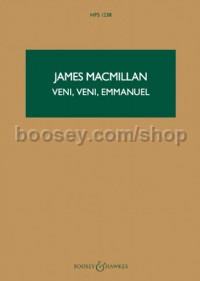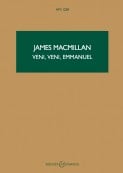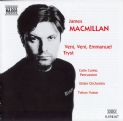Veni Veni Emmanuel (Hawkes Pocket Score - HPS 1238)
Veni Veni Emmanuel (Hawkes Pocket Score - HPS 1238)
* Estimated price converted from UK retail price
Veni, Veni, Emmanuel, a concerto for percussion and orchestra is in one continuous movement and lasts about 25 minutes. Dedicated to my parents, it is based on the Advent plainsong of the same name and was started on the 1st Sunday of Advent 1991 and completed on Easter Sunday 1992. These two liturgical dates are important as will be explained later. The piece can be discussed in two ways. On one level it is a purely abstract work in which all the musical material is drawn from the 15th century French Advent plainchant. On another level it is a musical exploration of the theology behind the Advent message.
Soloist and orchestra converse throughout as two equal partners and a wide range of percussion instruments are used, covering tuned, untuned, skin, metal and wood sounds. Much of the music is fast and, although seamless, can be divided into a five-sectioned arch. It begins with a bold, fanfare-like ‘overture’ in which the soloist presents all the instrument-types used throughout. When the soloist moves to gongs and unpitched metal and wood the music melts into the main meat of the first section – music of a more brittle, knottier quality, propelled forward by various pulse rates evoking an ever-changing heartbeat.
Advancing to drums and carried through a metrical modulation the music is thrown forward into the second section characterised by fast ‘chugging’ quavers, irregular rhythmic shifts and the ‘hocketting’ of chords between one side of the orchestra and the other. Eventually the music winds down to a slow central section which pits cadenza-like expressivity on the marimba against a floating tranquillity in the orchestra which hardly ever rises above ppp. Over and over again the orchestra repeats the four chords which accompany the words ‘Gaude, Gaude’ from the plainsong’s refrain. They are layered in different instrumental combinations and in different speeds evoking a huge distant congregation murmuring a calm prayer in many voices.
A huge pedal crescendo on Eb provides a transition to section four which reintroduces material from the ‘hocket’ section under a virtuoso vibraphone solo. Gradually one becomes aware of the original tune floating slowly behind all the surface activity. The climax of the work presents the plainsong as a chorale followed by the opening fanfares, providing a backdrop for an energetic drum cadenza. In the final coda the all-pervasive heartbeats are emphatically pounded out on drums and timps as the music reaches an unexpected conclusion.
The heartbeats which permeate the whole piece offer a clue to the wider spiritual priorities behind the work, representing the human presence of Christ. Advent texts proclaim the promised day of liberation from fear, anguish and oppression, and this work is an attempt to mirror this in music, finding its initial inspiration in the following from Luke 21: "There will be signs in the sun and moon and stars; on earth nations in agony, bewildered by the clamour of the ocean and its waves; men dying of fear as they await what menaces the world, for the powers of heaven will be shaken. And they will see the Son of Man coming in a cloud with power and great glory. When these things begin to take place, stand erect, hold your heads high, because your liberation is near at hand".
At the very end of the piece the music takes a liturgical detour from Advent to Easter - right into the Gloria of the Easter Vigil in fact – as if the proclamation of liberation finds embodiment in the Risen Christ.
James MacMillan






